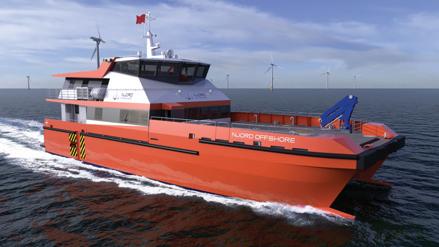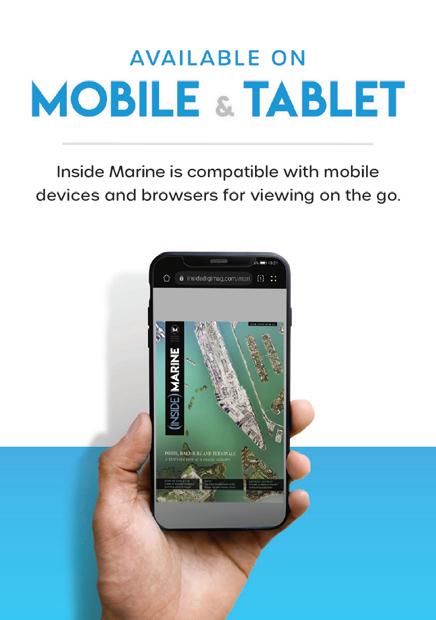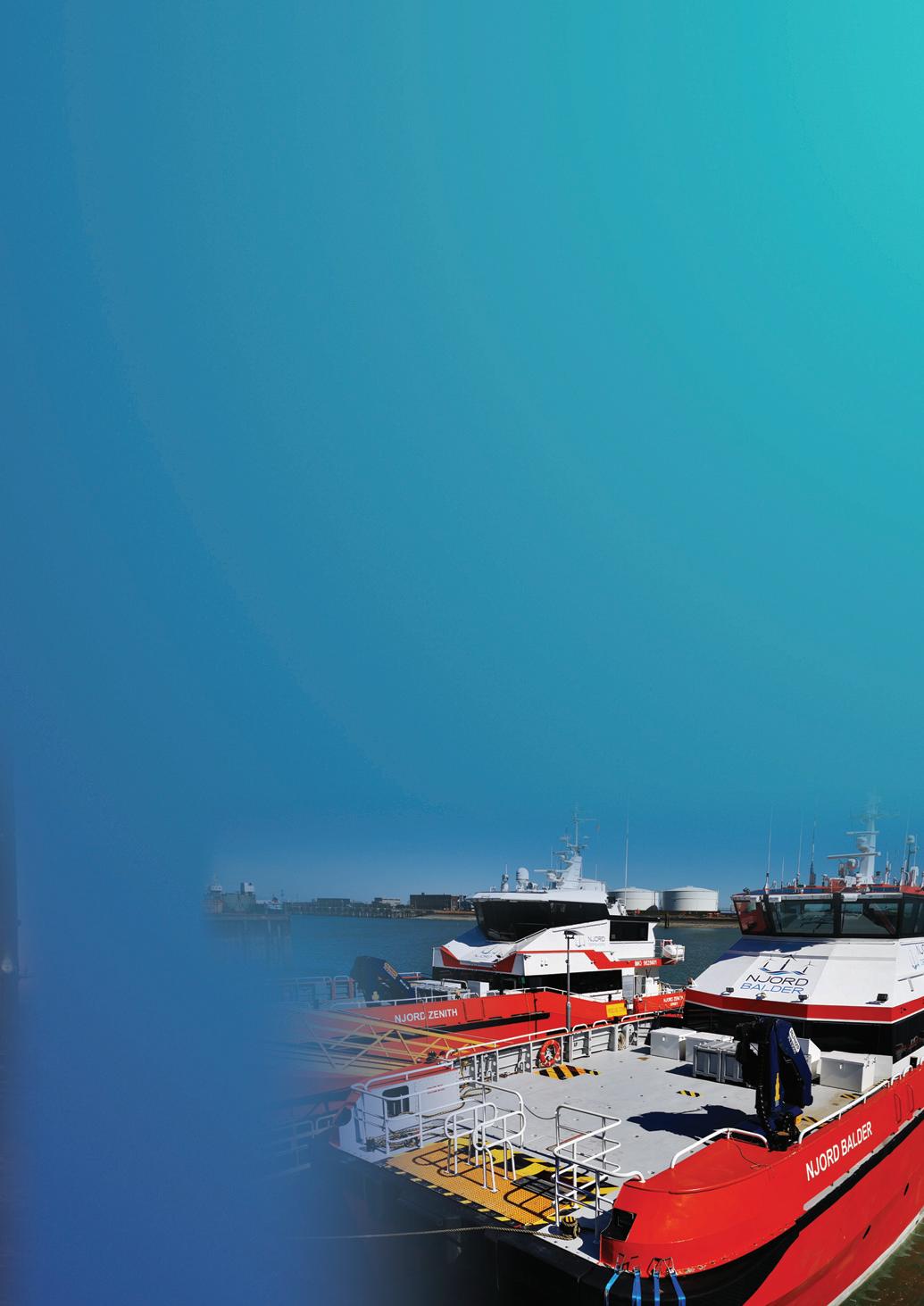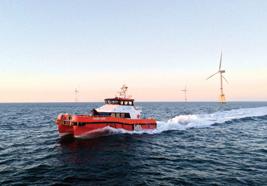





When Europe’s growing number of offshore wind turbines require maintenance, more and more companies are turning to Njord Offshore to safely and reliably carry technical staff and supplies to and from offshore wind installations. CEO Tom Mehew chatted with Richard Hagan about the challenges and excitement involved with working in offshore wind.
Amidst the ongoing climate change crisis, countries around the world have rapidly turned to renewable energy as a core part of the future of their energy supply. For many countries, this has meant the development of vast off shore wind farms.
But for all of their advanced technology, offshore wind turbines still require a human hand in the form of ongoing maintenance, repairs and general upkeep.
Njord Offshore, headquartered in Tendring on the UK’s east coast in Essex provides vital seaborne transport ser


vices that carry wind turbine technicians and their supplies out to offshore wind farm installations.
Sophistication at sea Managing Director Tom Mehew established Njord Offshore in 2013 in collaboration with a Norwegian ship owner. The company owns and operates a fleet of 21 modern, sophisti cated and highly advanced crew transfer vessels (CTVs) servicing offshore wind farms throughout Europe. It also has a smaller fleet operating within a joint ven ture in Taiwan.
Njord Offshore’s fleet consists entirely of catamaran hulled vessels, all of them custom-designed, many by famed naval architecture firm BMT Nigel Gee. According to Mr Mehew, the boats were specifically designed to be the most efficient and appro priate for the company’s needs.
“We spent lots of time in computational fluid dynamics modelling to design the most efficient hull forms. The testing has delivered CTVs that are fast and efficient, and boast reliable machinery. But they’re a very good cargo platform as well, so they really work well for our sector.”






The use of catamaran hulls ensures each vessel’s crew and passengers enjoy a stable, safe ride capable of safely tackling even the most demanding sea conditions. But just as the fleet’s hull designs were carefully con sidered, so too is the range of propulsion systems within it.
Njord Offshore’s boats use a range of propulsion systems that include fixed pitch propellers, controllable pitch pro pellers, and Volvo IPS systems.
Volvo’s IPS (Inboard Performance System) is a unique, pod-based propulsion system consisting of independent, forward facing propellers each attached to its own independent engine. This system has many benefits, including excellent fuel efficiency, lower emissions, and substan tial bollard pull.
But the standout benefit is the superior manoeuvrability it offers the captain since each pod drive is capable of moving inde pendently of the others. That’s critically important for manoeuvring the vessel on to the turbine in rough seas for the techni cians to embark or disembark.
The company’s IPS-equipped vessels utilise quad IPS installations, with two motors fitted to each hull. “This redun dancy allows us to continue operations, even in the event of an engine breakdown,” said Mr Mehew. “This redundancy allows continuous operations and can make a big difference for our clients, especially when we’re supporting the likes of jack-up ves sels which are very expensive to charter and are reliant on our operations.”
Njord Offshore has been so impressed with both the performance of the Volvo IPS systems as well as the manufacturer’s comprehensive support of the same, that the company has specified IPS propulsion into its latest new builds as well. “We’ve just signed two 32-metre quad IPS new builds with Ares Shipyard in Turkey,” Mr Mehew announced.
These two new boats were designed by Incat Crowther and will be an evolution of Njord Offshore’s existing 27-metre vessels. Designed with a ferrying capacity of 30 technicians, the big difference from the rest of the company’s fleet is that the new vessels prioritise offshore accommodation for its own seafarers.
“Typically the crew would sleep on an SOV (Service Operation Vessel) but with these new boats, they’ll be able to sleep on our boats,” Mr Mehew commented. “We’ve
done a lot of work on ensuring crew com fort with more space dedicated to the vessel’s crew.”
Mr Mehew’s enthusiasm for the offshore wind industry was clear and even infec tious as he described his passion for the trade and for the work that his teams do.
“Working in offshore wind has more benefits than just being in the marine sector. We’re supporting a sector which is helping build a more sustainable future for our children.

“This is no longer just a cottage industry,” he noted. “In 2021, we serviced a huge number of turbines – it was the equivalent of approximately seven times the electricity generation capacity of the UK’s largest nuclear power plant. It’s a very established industry that has scaled up very efficiently and we expect that to continue. And as tur bines have grown and become more efficient, we’re seeing that it’s more economical to build them further offshore while also util ising different foundation structures such as floating foundations.”
Njord Offshore maintains a robust shore side network supporting its vessels across Europe. The company has fleet engineers available 24/7 on the road carrying essen
NJORDtial spares and attending various sites, where they assist with urgent defects or breakdown responses. The company also has several workshops strategically located around Europe, storing additional spare parts.
In total, Njord Offshore’s staff comple ment consists of 20 office staff and 130 seafarers, 40% of whom are British with the remainder drawn from across Europe. All are additionally supported by a trusted network of subcontractors.



“We work with some fantastic people and companies who are truly experts in their field, whether that’s on the opera tions, technical or health and safety side,” Mr Mehew proudly explained. “We get excellent feedback on our crews. There’s nothing better than when your clients come back to you and thank you for doing an excellent job with well-trained, pro fessional crew.
“We invest a lot of time and effort into running a reliable service and though we’re not perfect, we’ll keep trying.”
Whilst renewable energy is a constantly growing industry, Mr Mehew revealed that it isn’t immune from the various pressures experienced in most any other industry.
“Energy security is a big theme in the light of current geopolitical events, so it’s a really interesting time for the industry. Since offshore wind is a highly scalable

production source, we see a lot of people going down the offshore wind route. But there are also several pressures on the industry.” One of those, he said, is finding enough people to fuel that growth.
“The people have to come from some where, and with the UK and Europe’s low unemployment rates, staffing is a real challenge for our sector.
“Inflationary pressures are also having an impact; it is affecting both our staff and our seafarers. It’s impossible to ignore that. And on the flip side of that, the utility com panies are focused on reducing the cost of electricity generation so they’re trying to drive down the cost of operations like ours. It’s a difficult position to be in, but ultimately we believe our clients need operational excellence to ensure reliable operations for themselves. They will have to accept these inflationary increases over the next few years.”
Mr Mehew further bemoaned long lead times for spare parts. “The economic situ a tion resulting from Covid has also increased the lead times for machinery and parts, with some parts having in excess of one year lead times. That’s a major challenge that demands good planning to ensure that we have enough stock and critical spares to continue pro viding a reliable service.”
Despite these challenges, Njord Offshore’s Managing Director remains optimistic about the industry’s future, and concluded our
chat with his enthusiasm for its prospects: “I’m very optimistic and in fact I’ve never been more optimistic about the offshore wind industry and its future.
“With energy security a key issue world wide and decarbonisation targets having been set around the world, the offshore wind industry is one of the few industries that is positioned to make a substantial difference in meeting those targets.” n
